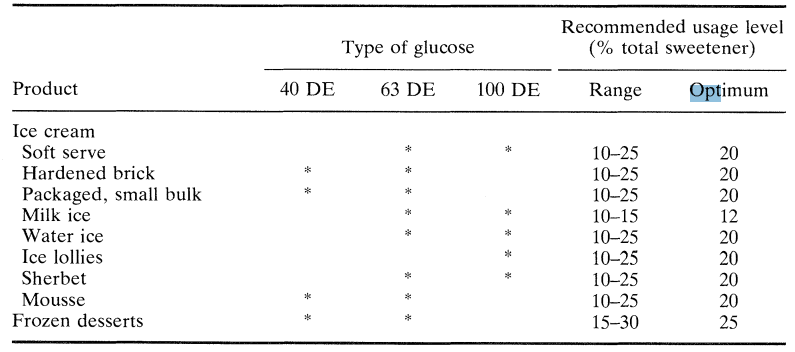Ice cream
In general terms, ice cream may be defined as an emulsion of fat, sugar, and milk solids non-fat which has been simultaneously whipped and frozen. Unless the product is described as ‘dairy ice cream’ the fat need not necessarily be of dairy origin, i.e. butter or cream. The legal standards of composition are contained in the ‘Ice Cream Regulations’ No. 1866, 1967. The consumer appeal of ice cream is greatly enhanced by the addition of flavors. Traditionally, the most important of these are vanilla, fruit, fruit extracts, coffee, and chocolate.
Ice cream is presented to the consumer in a number of different ways. It is served, from mobile vans, by scooping into biscuit cones or wafers, out of small bulk containers. In recent years soft-serve ice cream has become very popular, where the product is drawn straight from the freezer for direct consumption. For domestic use as a dessert, ice cream is sold by the retailer in cartons or plastic tubs and stored by the consumer in the freezer until required. Basically, the same method is used by hotels, restaurants, and other institutions which serve ice cream as a dessert or part of a dessert course.
Milk ice
The manufacture of this product, also known as ‘ice milk’, is covered by ice cream regulations, being a type of ice cream low in fat and milk solids. Unlike standard ice cream, the fat used in the manufacture of milk ice must be derived wholly from milk. Although by no means as popular as ice cream, milk ice is very refreshing and should appeal to the calorie-conscious consumer.
Water ice and ice lollies
Water ice and ice lollies are frozen confections that do not contain milk solids or fat. They are, in effect, frozen sugar syrups of about 15-25% solids content, usually colored, fruit flavored, and containing a small quantity of citric acid. Water ice and ice lollies differ in that the former is drawn from the freezer with about 20% overrun, while the latter is frozen in molds without aeration. Ice lollies containing fruit juice are particularly refreshing.
The function of glucose in ice cream and frozen desserts
Sweeteners are essential constituents in ice cream and frozen desserts and greatly enhance their general palatability. Their sweet taste balances the flavor of the fat and accentuates the creaminess of milk solids. By contributing to the total solids content of an ice cream mix, sugars exert a beneficial effect on the body, texture, and meltdown of the product. As true solutes, they also influence the freezing characteristics of the mix. Ice creams deficient in sugars are generally of crumbly, coarse or flaky texture and lacking in sweetness. Conversely, excess sugars yield a heavy, soggy texture, as well as over sweetness, and in extreme cases may create difficulties in freezing. It is important, therefore, to strike a correct balance of ingredients in the formulation of frozen dairy products and also, in the case of ice creams, to select a total mix appropriate to the type of freezer. Although cane or beet sugar (sucrose) is the prime sweetener used in the preparation of ice cream and frozen desserts, a valuable range of complementary carbohydrates exists in the form of glucose syrups. In combination with sucrose, the glucose syrup provides significant benefits to the manufacturer by adding another dimension of flexibility in his formulations. Depending on the particular glucose syrup selected, and by utilizing its specific functional properties, a much wider degree of control may be exerted on sweetness, body, melt down and texture than by the use of a single sweetener. In order to gain the maximum benefit from the versatility of glucose syrups it is necessary to consider in more detail how they influence the properties of frozen dairy products. Their main functions are as follows:
- to control body and texture,
- to confer sweetness,
- to improve shelf life,
- to provide a nutritious source of milk solids.
Selection and use of glucose in ice cream and frozen desserts
The carbohydrate composition and functional properties of glucose differ markedly and largely depend upon their degree of conversion. Syrups that can be used vary widely from a 20 DE maltodextrin to dextrose itself at 100 DE. Although they can be included in certain formulations to achieve specific effects, their random and haphazard use can create problems for the manufacturer. For example, a manufacturer might select dextrose monohydrate in order to retain maximum sweetness in hardened ice cream bricks. Unfortunately, the effect upon the mix freezing point would probably cause unacceptable softening of the product. On the other hand, its use is ideal in soft-serve ice cream and ice lollies. In ice lollies, which usually are low in solids content, dextrose monohydrate exerts a beneficial softening of texture. It also helps to prevent the surface crusting of sugar crystals and ‘white spots’ caused by the expulsion of dye (Table 1).

By virtue of its high molecular weight constituents, maltodextrin at 5% of the mix weight will give complete protection against the development of coarseness in stored ice cream, but the texture will be too ‘chewy’. However, it will replace 10% of the non-fat milk solids in ice cream with improvement of texture and provide a useful cost benefit.
Generally, the most useful glucose syrups for ice cream and sherbet formulations are the 63 DE types. Their balance of carbohydrates is such that they provide adequate sweetness and yet contain sufficient ‘higher sugars’ (sugars of high molecular weight) to ensure smoothness of texture and protection against coarseness. Furthermore, their freezing point depression is fairly close to that of sucrose giving a very slight softening effect.
When it is desirable to build up total solids and yet necessary to avoid oversweetness, 40 DE glucose syrups and high maltose glucose syrups are recommended. Their use is often preferred in sherbets, mousse and a wide variety of frozen desserts, for smoothness and bodying of texture.
